Another of those ‘new eras’ I talked about in yesterday’s post is involved in the latest news on gravitational waves. Let’s not forget that it was 50 years ago — on November 28, 1967 — that Jocelyn Bell Burnell and Antony Hewish observed the first pulsar, now known to be a neutron star. It made the news at the time because the pulses, separated by 1.33 seconds, raised a SETI possibility, leading to the playful designation LGM-1 (‘little green men’) for the discovery.
We’ve learned a lot about pulsars emitting beams at various wavelengths since then and the SETI connection is gone, but before I leave the past, it’s also worth recognizing that our old friend Fritz Zwicky, working with Walter Baade, first proposed the existence of neutron stars in 1934. The scientists believed that a dense star made of neutrons could result from a supernova explosion, and here we might think of the Crab pulsar at the center of the Crab Nebula, an object whose description fits the pioneering work of Zwicky and Baade, and also tracks the work of Franco Pacini, who posited that a rotating neutron star in a magnetic field would emit radiation. Likewise a pioneer, Pacini suggested this before pulsars had been discovered.
Writing about all this takes me back to reading Larry Niven’s story ‘Neutron Star,’ available in the collection by the same name, when it first ran in a 1966 issue of IF. Those were interesting days for IF, but I better cut that further digression off at the source — more about the magazine in a future post. ‘Neutron Star’ is the story where Beowulf Shaeffer, a familiar character in Larry’s Known Space stories, first appears. If you want to see a neutron star up close and learn what its tidal forces can do, you can’t beat Niven’s tale.
